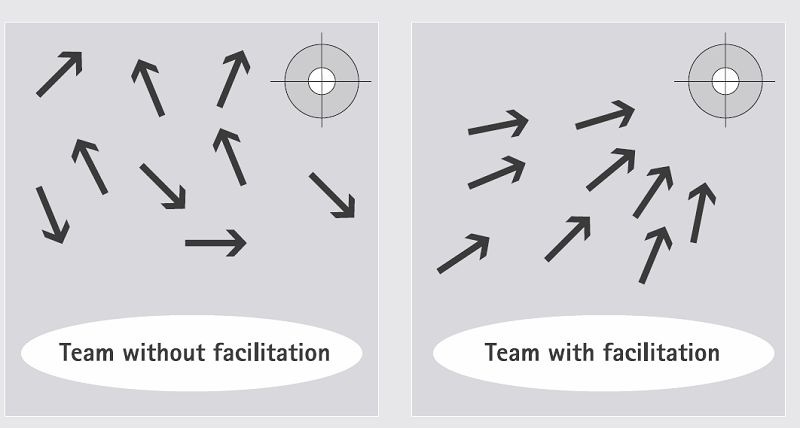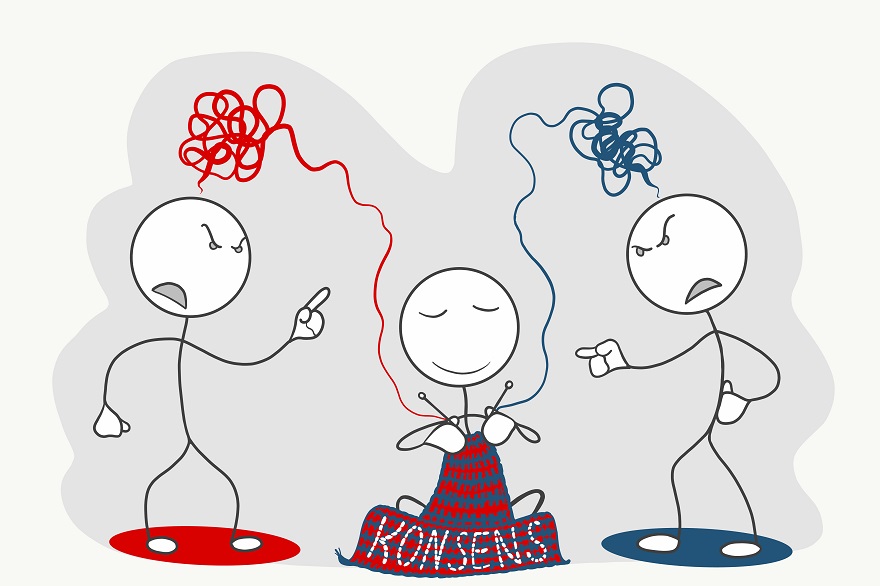Do you know this? You come to a meeting, and slowly the individual participants trickle in. The meeting gets going, and after a short time, the discussion gets lost in detail. Half of the participants are not interested and one by one, they start to work on their e-mails on their notebook or smartphone (this danger of distraction is particularly significant in online meetings). Then, 15 minutes before the end of the session, you realise that several topics have not yet been dealt with. The meeting is adjourned, and everyone leaves the room frustrated: “… another one of those pointless meetings”. I’m sure we’ve all experienced meetings like this at one time or another.
Reason enough to take a look at the topic of moderation again. In this article, I have compiled what I consider to be the ten most important success factors for successful facilitation. Whether it’s a team meeting, a project workshop or a large group event – if you take these points into account, at least the conditions for a successful conference are in place.
By the way, these points are equally valid for face-to-face meetings for online meetings. I would even say that a well-prepared moderation is even more critical for the success of an online meeting than for a face-to-face meeting.
1. Preparation – the foundation of success
Yes, you have read correctly. If you have the task of facilitating a meeting, the job starts long before the actual meeting. First of all, you have to clarify what the goal of the meeting is. The Coverdaletarget is excellent for this, for example. Other important points are: Drawing up an agenda and a timetable, selecting and inviting participants, choosing the necessary documents and tools, determining the room and setting, etc.
By the way, you can also find a comprehensive checklist for preparation on our homepage in the “Blog” section.
2. Entry into the meeting
The course for a successful meeting is often set in the first few minutes. If not, all participants know each other, and (at least brief) round of introductions is obligatory. It is also essential to explain the goal of the meeting and ideally to establish a common perspective on it. It is usually also useful to ask about and clarify expectations and fears at the beginning. It is also helpful to agree on the rules of the game for the meeting and to briefly introduce the process and the agenda of the meeting. Finally, at the end of the introductory phase, the transition to the first agenda item or the introduction to the topic should take place.
3. Separation of content and process
An important rule is: “The facilitator is responsible for the process, the participants are responsible for the content”. So the facilitator should always ask himself: “Is what is happening helpful for achieving the goal of this meeting? In contrast, he or she should be more reserved when discussing the content. This requires a certain degree of self-discipline and self-reflection, especially for topics that are of particular interest to the facilitator or that have an impact on the facilitator.

4. Neutrality and impartiality of the moderator
If a situation arises during the meeting where different points of view are formed, compliance with Rule 3 is critical. Here it is essential not to take one side or the other, but to remain neutral. This also means taking all contributions equally “important” and valuing all participants equally – summarised in the term “all-partiality”. This may sound simple, but in practice, it is one of the most significant challenges for the moderator. Even if the facilitator is not part of the team and there is no entanglement in the content, he or she at least has an opinion on the subject. Being able to put this in the background and remain neutral even under challenging situations is one of the essential skills of a good moderator.
5. Disturbances have priority
Whether it is the famous “frequent speaker” or the participant who is always talking on the phone in the room – there are many types of disruptions in the process. The facilitator’s task is to notice these disturbances and then take appropriate action to eliminate them. The way this is done depends, of course, very much on the personality of the facilitator and his or her leadership style (process leadership is also a kind of direction). In any case, a lot of tact and experience is needed here. Even though there are no “patent remedies”, here is a small guideline for dealing with participants who behave disruptively:
- Perceive the effect of the behaviour on yourself
- Observe the effect of the behaviour on the group
- Address the behaviour and the impact
- Agree on rules of the game or refer to agreed rules of the game
- Try to find out what is behind the behaviour if it continues: What leads to this behaviour? What could be the intention behind it? Speak out your suspicions.
- Together with the participant, think about what he or she needs to cooperate.
- What can the group also contribute?
6. Dynamic group process and dealing with emotions
In every meeting, two processes run in parallel: a structured approach on the factual level and a group-dynamic process on the emotional and relationship status.
Taking this second level into account distinguishes the good facilitator from the excellent one. When people work together in a team, the following phases are distinguished:
- Orientation phase
- Conflict phase
- Stability phase
- Service phase
- Separation phase
Depending on the type of meeting or workshop and the composition of the participants, these phases may take different lengths of time or may not be reached at all. The facilitator must take the steps of the group process into account in his or her approach, for example, when designing the introductory phase of the factual process. Certain behaviours of the team members help the facilitator to recognise the steps of the group process and to react accordingly.
7. Meta-reflections and interstitial flashbacks
Especially (but not only) in longer meetings or workshops, but it is also helpful to evaluate the progress with the participants in between. In this case, the content level is deliberately left behind, and the participants are invited to give feedback on the process. The facilitator asks questions such as
- How are we doing with the cooperation in this meeting?
- How close are we to achieving the meeting goal?
- What else is needed, or what do we need to change for the rest of the meeting?
It is essential to introduce these flashbacks well and to make it clear that this step is not about a discussion of content, but exclusively about a process review.
8. Sensible use of facilitation techniques and tools
There are a considerable number of facilitation techniques and tools. Here are a few examples of face-to-face and online meetings:
Presence meetings:
- Visualisation techniques (e.g. flipchart, moderation cards, adhesive dots, …)
- Creativity techniques (e.g. brainstorming, mind maps…)
- Constellations in space (e.g. to agree / disagreement on a topic visible)
OnlineMeetings:
- Electronic whiteboard (I prefer to use MS Whiteboard for simple tasks or Miro for more complex topics)
- Instant polls (yes, depending on the video conferencing tool used)
- Desktop sharing
Regardless of the setting:
- Questioning techniques (e.g. scaling questions, questions about exceptions, classification questions, …)
- Techniques for reaching decisions (e.g. majority voting, …)
- Flash technology (where do we stand?)
Precisely because there are so many tools, it is all the more important to think carefully about which one to use. The two primary questions are:
- What goal do I want to achieve?
- Which tool is best suited to achieve this goal?

9. Conclusion of the meeting and review
Just as important as a clean start to the meeting is a clean end to the forum. This also includes the binding agreement of an action plan: “Who does what by when” should be clarified for all open points. It should also be defined how this action plan is to be followed up after the meeting. A follow-up meeting may also be necessary. In this case, it should be clarified who will organise it and by when.
Ideally, there is also a final review of the cooperation and the process at the end of the meeting, similar to point 3.
Last but not least, it would be nice to end the meeting on a positive note. For example, the facilitator can thank the participants for their constructive cooperation and (if available) appreciate the positive thematic development.
10. Follow-up
After the meeting is before the meeting. The preparation of meeting minutes summarising the results and the action plan is usually the last step for which the facilitator is responsible.


Recent Comments